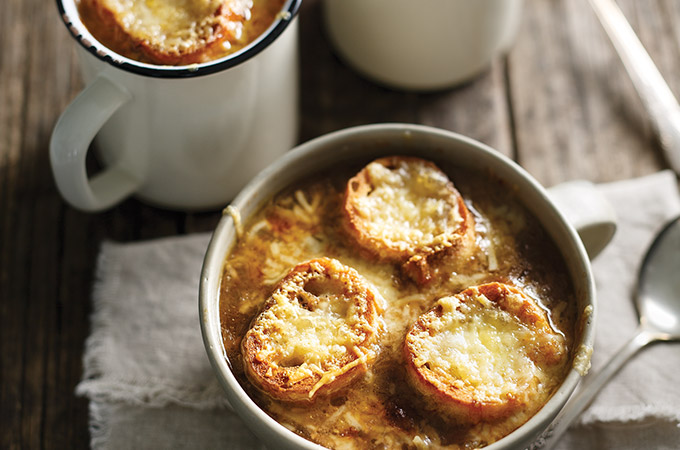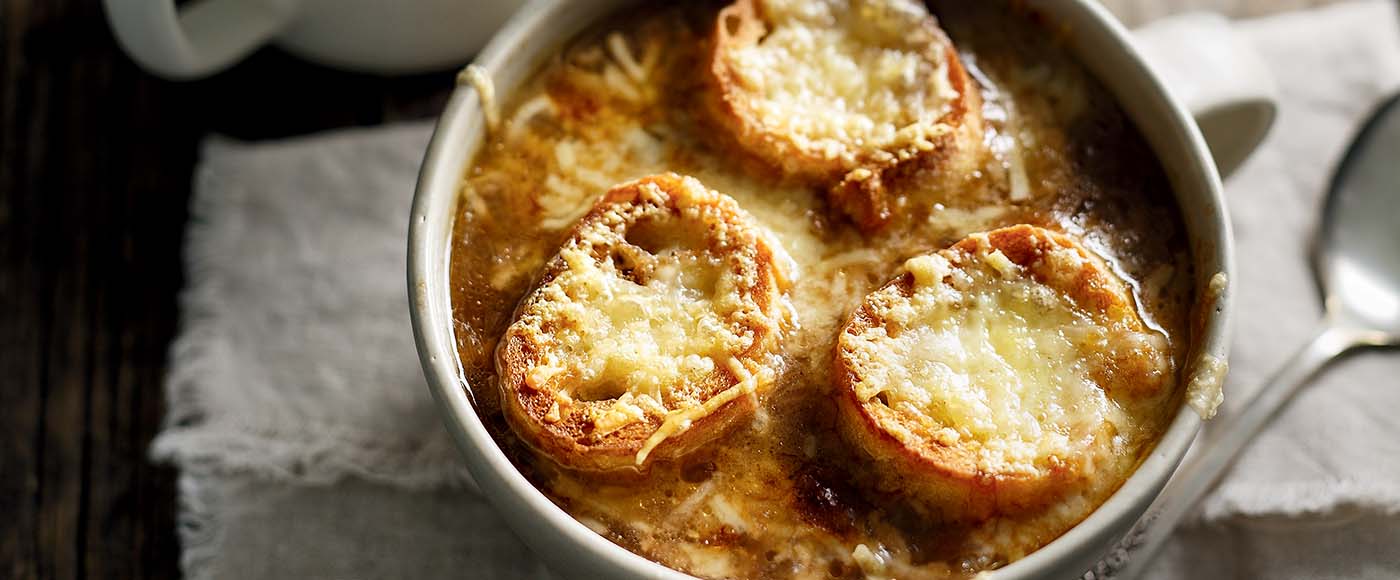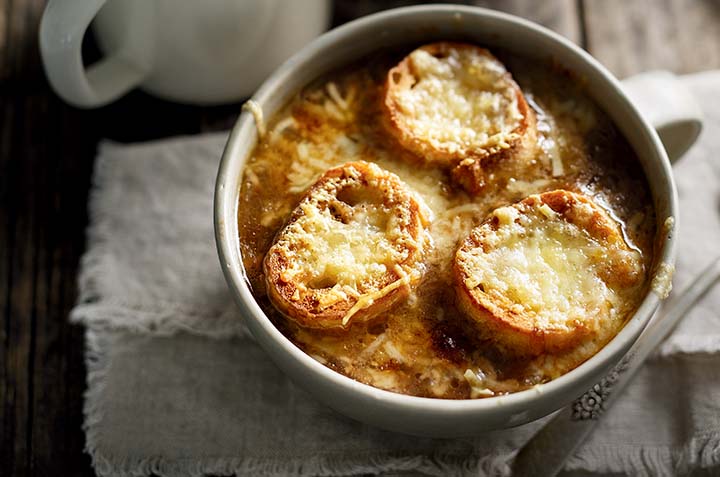1. French Onion Soup (the Best)
Onion broth, crispy croutons and melted cheese practically make this soup a complete meal.
Useful tips:
- By using toasted flour, the soup will have a richer flavour and the ingredients will bind better, without the risk of a sticky or gluey texture caused by white flour. You can grill the flour yourself or buy it pre-grilled at the grocery store.
- No brandy or red wine? Beer can easily replace wine, while brandy is a perfect substitute for cognac. Another option? Leave out the alcohol altogether!
- The way you cut the onions is very important here. We want thin strips that are short enough to easily fit in a spoon.
- You can vary the cheese which garnish your onion soup as long as it has a pronounced taste and elastic texture once melted. The Gruyère chosen for this recipe ticks both those boxes.

Soups and Broths
French Onion Soup
(The Best)
2. Vegetable and fava bean soup
This is the perfect soup to accompany a grilled-cheese or lunchtime sandwich.
Useful tips:
- For a more nourishing bowl of soup, don’t hesitate to add pasta, rice or grains that have already been cooked (such as short pasta, orzo, broken spaghetti, barley) before serving.
- A handful of cheese curds can be placed in the bottom of the bowl right before ladling. It will start to melt, add a pleasant salty taste as well as a little “squeakiness” to your lunch.
- Replacing fava beans in this recipe with edamame is a great substitute as they have a similar texture.
- We chose Italian tomatoes as they break down well and thicken the broth, while Canadian tomatoes tend to remain intact, making the soup chunky and watery.

Soups and Broths
Vegetable and Fava Bean Soup
3. Pea soup
Conjuring memories of our grandparents (or parents!), this classic sugar shack special is one of Quebec’s great culinary traditions.
Useful tips:
- This recipe requires cooking liquid from a simmered ham, but if you don’t have any on hand, replace it with the same amount of chicken broth.
- To save time, pre-soak the yellow peas. Bring them to a boil, remove from heat and let sit for 30 minutes. You may need to adjust the cooking time of the soup: you’ll know it’s ready when the peas start to break down and no longer have a chalky texture.
- This recipe can be made in the slow cooker. Set the temperature to a low intensity and cook for 6 hours. You can also cook the pea soup in the pressure cooker for 20 minutes, at high pressure.
- Only have split peas in the pantry? They can also be used, but you may need to adjust the soup’s consistency at the end by adding more broth.

Soups and Broths
Pea Soup
4. Curried squash soup
Spicy and fragrant, this soup’s aroma fills the house while it simmers. It also helps that curry and squash are a match made in soup heaven.
Useful tips:
- This soup has a nice intensity of spice with generous curry flavour and the pronounced zing of ginger. If you prefer your soups a little bit subtler, simply adjust the amount of spice accordingly.
- The texture of this soup may vary depending on the squash used, as some contain more water than others. To ensure a thick and creamy soup, you can add a cubed potato to the recipe.
- Cream is rarely added when making our soups for a very simple reason: We like to highlight the vegetables used. Cream can mute other ingredients’ flavours. If you like, though, add a drizzle right before serving. Bonus: Cream-free soups also freeze better!

Soups and Broths
Curried Squash Soup
5. Chicken and barley soup
Chicken soup is known to help fight runny noses and sore throats, and this one is the ultimate remedy for our little patients (as well as healthy ones) all winter long.
Useful tips:
- This soup can take on many personalities depending on the ingredients on hand. Carrots can easily be replaced with parsnips or celeriac, and fresh herbs and arugula work wonders as a garnish.
- Hulled barley (or barley groats) retain their whole grain and germ, while pearl barley has undergone processing and has been stripped of its germ. Hulled barley is more nutritious and can be used here, but you’ll need to add an extra 10 to 15 minutes of cooking time.
- You can use leftover chicken or turkey instead of raw chicken, just add it in at the end to warm it through. If you add cooked chicken too early, the meat will fray and scatter throughout your nice soup.


